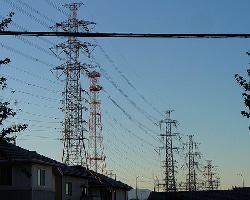
As we continue to surround ourselves with technology, more and more information is surfacing linking health problems and the electromagnetic fields produced by many of these modern conveniences.
It's difficult to have an intelligent conversation about electromagnetic fields (EMFs)-also called Electric and Magnetic Fields-without getting into a technical discussion, but a simplified understanding of the physics behind this ever-increasing environmental toxin can help you protect your family from these dangerous invisible waves.
EMFs are invisible lines of force that surround any electrical device. A "field" is the area in which charges interact with other charges-and with humans and animals. Electromagnetic fields consist of electric and magnetic components traveling together. These electrically charged waves travel at the speed of light and are characterized by both a frequency and a wavelength.
All "man-made" EMFs are measurable-the frequency is simply the number of oscillations in the wave per unit of time. They are measured in units of hertz; 1 Hz = 1 cycle per second. The wavelength is the distance traveled by the wave in one oscillation (or cycle).
If a current flowing through a conductor (wire) is made to oscillate at a very rapid rate, 3 KHz or greater, it is considered to be a radio frequency. At the speed of light, these waves radiate outward from the source in a pulsating pattern, much like the waves in the pond; this phenomenon is known as electromagnetic radiation.
We measure EMFs in four ways: Electric fields, magnetic fields, dirty electricity, and radio frequency fields.
Electric Fields
Electric fields are measured in Volts per meter (V/M). They are always present on charged electrical wires and devices plugged into live outlets, and they are created by differences in voltage. The higher the voltage, the stronger the resultant field will be.
AC electric fields are present any time an electric device or power cord is plugged in to an electric outlet. An electric field will exist even when there is no current flowing. For example, when you plug in a lamp or clock radio it will emit an electric field even when not turned on. To measure electric fields we use an electric field strength meter.
Common electric fields exposure points: Energy-efficient CFL bulbs, laptop computers and peripherals, poorly grounded electrical wiring, metal lamps and clock radios.
Magnetic Fields
Magnetic fields are measured in milligauss (or microtesla) and are created when electric current flows. When current flows, the strength of the magnetic field will vary depending upon the amount of current (amps) drawn through the conductor, but the electric field strength will be constant. To measure magnetic fields we use a gauss meter.
Magnetic fields exposure points include: Power lines and electrical wiring and cords, faulty electrical wiring, knob and tube wiring, computers, CRT (cathode ray tube) TVs and monitors.
Dirty Electricity
Today, for a number of reasons, our AC power is becoming increasingly contaminated with invisible microsurges of dangerous high frequency energy called "dirty" electricity.
Dirty electricity has become a steadily growing problem in recent years due to our increased use of energy efficient CFL bulbs, dimmer switches, modern low-voltage lighting and electronic devices such as gaming systems and computers. All of these electrical devices contain power supplies that operate at a high frequency. They essentially "chop-up" our conventional AC power, using it in short bursts as opposed to a smooth continuous flow of current. This constant stopping and starting of the electrical current causes a combination of what engineers call "electrical transients and harmonics." In layman's term's it's referred to as "electrical feedback" or "electrical noise." Dirty Electricity is measured in Graham-Stetzer units (GS) using a Microsurge meter.
Dirty Electricity exposure points include: Power lines, cords, electrical appliances and electronic devices plugged into circuits reading greater than 25-50GS units.
Radio Frequency Fields
Radio Frequency fields are measured in microwatts per square centimetre and can be measured using an RF meter.
Cell phones, cordless phones and wireless networks produce radio waves and operate in the millions to billions of hertz (megahertz and gigahertz, respectively). These waves are often referred to as microwaves because of their small wavelengths, and because they are radio waves, they can travel long distances. Humans have harnessed much of the radio spectrum for communication purposes such as Wi-Fi, cell phone, radio, satellite TV and radar.
Radio frequency exposure points include: Devices such as PDAs, cell phones, microwave transmitters, BlueTooth technology, DECT cordless phones and baby monitors, Wi-Fi routers; and dirty electricity, much of it measured in the RF range.




